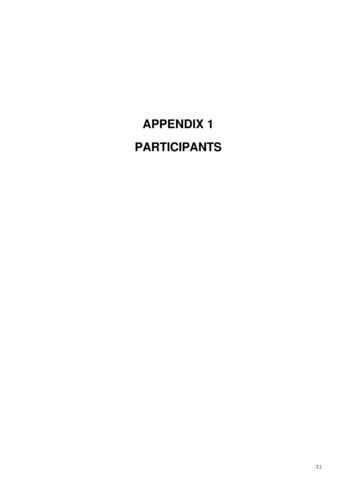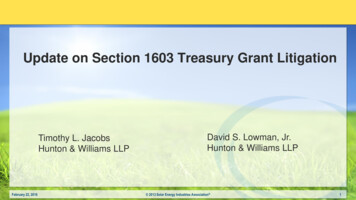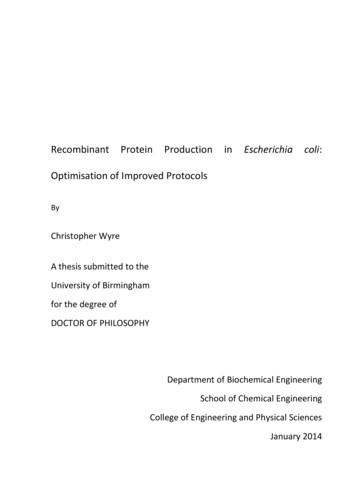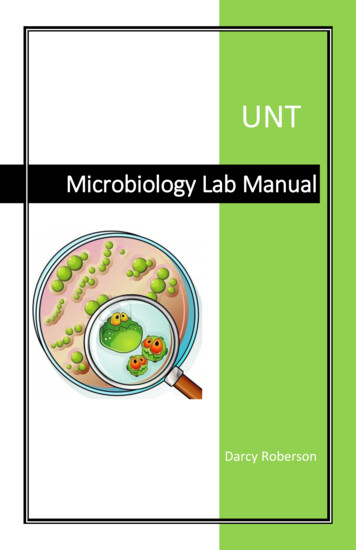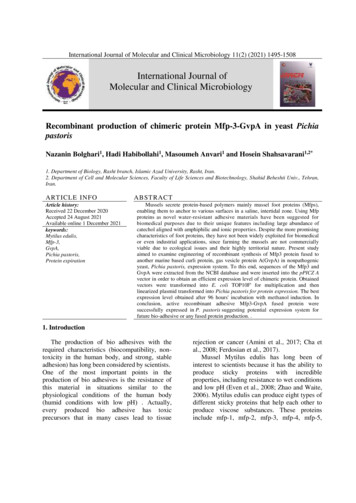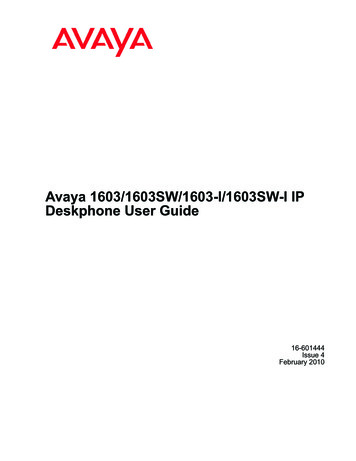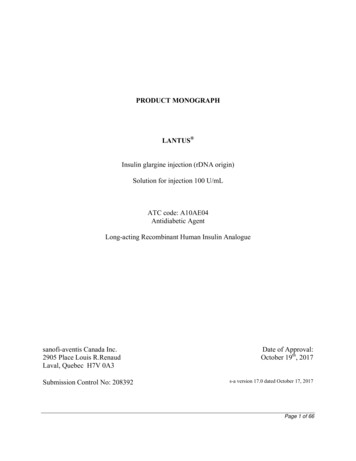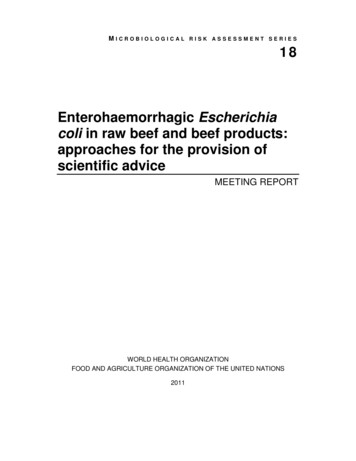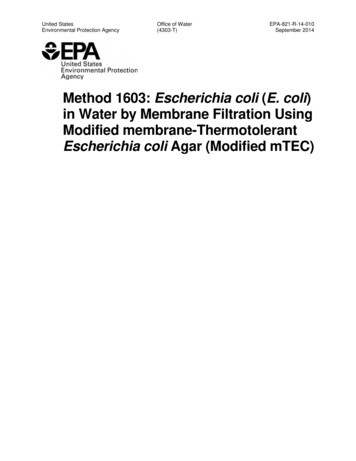
Transcription
Method 1603: Escherichia coli (E. coli) inWater by Membrane Filtration UsingModified membrane-ThermotolerantEscherichia coli Agar (Modified mTEC)December 2009
U.S. Environmental Protection AgencyOffice of Water (4303T)1200 Pennsylvania Avenue, NWWashington, DC 20460EPA-821-R-09-007
AcknowledgmentsThe following laboratories are gratefully acknowledged for their participation in the validation of thismethod in wastewater effluents:Volunteer Research Laboratory EPA Office of Research and Development, National Risk Management Research Lab: Mark C.MeckesVolunteer Verification Laboratory City of Los Angeles Bureau of Sanitation: Farhana Mohamed, Ann Dalkey, Ioannice Lee, GenevieveEspineda, and Zora BaharianceVolunteer Participant Laboratories City of Los Angeles Bureau of Sanitation: Farhana Mohamed, Ann Dalkey, Ioannice Lee, GenevieveEspineda, and Zora Bahariance County Sanitation Districts of Los Angeles County (JWPCP): Kathy Walker, Michele Padilla, andAlbert Soof County Sanitation Districts of Los Angeles County (SJC): Shawn Thompson and Julie Millenbach Environmental Associates (EA): Susan Boutros and John Chandler Hampton Roads Sanitation District (HRSD): Anna Rule, Paula Hogg, and Bob Maunz Hoosier Microbiological Laboratories (HML): Don Hendrickson, Katy Bilger, and Lindsey Shelton Massachusetts Water Resources Authority (MWRA): Steve Rhode and Mariya Gofhsteyn North Shore Sanitation District (NSSD): Robert Flood Texas A&M University: Suresh Pillai and Reema Singh University of Iowa Hygienic Laboratory: Nancy Hall and Cathy Lord Wisconsin State Laboratory of Hygiene (WSLH): Jon Standridge, Sharon Kluender, Linda Peterson,and Jeremy Olstadt Utah Department of Health: Sanwat Chaudhuri and Devon Cole
DisclaimerNeither the United States Government nor any of its employees, contractors, or their employees make anywarranty, expressed or implied, or assumes any legal liability or responsibility for any third party’s use ofor the results of such use of any information, apparatus, product, or process discussed in this report, orrepresents that its use by such party would not infringe on privately owned rights. Mention of tradenames or commercial products does not constitute endorsement or recommendation for use.Questions concerning this method or its application should be addressed to:Robin K. OshiroEngineering and Analysis Division (4303T)U.S. EPA Office of Water, Office of Science and Technology1200 Pennsylvania Avenue, NWWashington, DC 20460oshiro.robin@epa.gov or OSTCWAMethods@epa.goviii
Table of Contents1.0Scope and Application . . . . . . . . . . . . . . . . . . . . . . . . . . . . . . . . . . . . . . . . . . . . . . . . . . . . . . . . . 12.0Summary of Method . . . . . . . . . . . . . . . . . . . . . . . . . . . . . . . . . . . . . . . . . . . . . . . . . . . . . . . . . . . 13.0Definitions . . . . . . . . . . . . . . . . . . . . . . . . . . . . . . . . . . . . . . . . . . . . . . . . . . . . . . . . . . . . . . . . . . . 14.0Interferences and Contamination . . . . . . . . . . . . . . . . . . . . . . . . . . . . . . . . . . . . . . . . . . . . . . . . . 25.0Safety . . . . . . . . . . . . . . . . . . . . . . . . . . . . . . . . . . . . . . . . . . . . . . . . . . . . . . . . . . . . . . . . . . . . . . 26.0Equipment and Supplies . . . . . . . . . . . . . . . . . . . . . . . . . . . . . . . . . . . . . . . . . . . . . . . . . . . . . . . . 27.0Reagents and Standards . . . . . . . . . . . . . . . . . . . . . . . . . . . . . . . . . . . . . . . . . . . . . . . . . . . . . . . . 38.0Sample Collection, Preservation, and Storage . . . . . . . . . . . . . . . . . . . . . . . . . . . . . . . . . . . . . . . 99.0Quality Control . . . . . . . . . . . . . . . . . . . . . . . . . . . . . . . . . . . . . . . . . . . . . . . . . . . . . . . . . . . . . . . 910.0Calibration and Standardization . . . . . . . . . . . . . . . . . . . . . . . . . . . . . . . . . . . . . . . . . . . . . . . . . 1411.0Procedure . . . . . . . . . . . . . . . . . . . . . . . . . . . . . . . . . . . . . . . . . . . . . . . . . . . . . . . . . . . . . . . . . . 1412.0Verification Procedure . . . . . . . . . . . . . . . . . . . . . . . . . . . . . . . . . . . . . . . . . . . . . . . . . . . . . . . . 1613.0Data Analysis and Calculations . . . . . . . . . . . . . . . . . . . . . . . . . . . . . . . . . . . . . . . . . . . . . . . . . 1614.0Sample Spiking Procedure . . . . . . . . . . . . . . . . . . . . . . . . . . . . . . . . . . . . . . . . . . . . . . . . . . . . . 1715.0Method Performance . . . . . . . . . . . . . . . . . . . . . . . . . . . . . . . . . . . . . . . . . . . . . . . . . . . . . . . . . . 2216.0Pollution Prevention . . . . . . . . . . . . . . . . . . . . . . . . . . . . . . . . . . . . . . . . . . . . . . . . . . . . . . . . . . 2317.0Waste Management . . . . . . . . . . . . . . . . . . . . . . . . . . . . . . . . . . . . . . . . . . . . . . . . . . . . . . . . . . . 2418.0References . . . . . . . . . . . . . . . . . . . . . . . . . . . . . . . . . . . . . . . . . . . . . . . . . . . . . . . . . . . . . . . . . . 24iv
List of AppendicesAppendices A and B are taken from Microbiological Methods for Monitoring the Environment: Waterand Wastes (Reference 18.5).Appendix A:Part II (General Operations), Section A (Sample Collection, Preservation, and Storage)Appendix B:Part II (General Operations), Sections C.3.5 (Counting Colonies) and C.3.6 (Calculationof Results).v
Method 1603: Escherichia coli (E. coli) in Water by MembraneFiltration Using Modified membrane- Thermotolerant Escherichia coliAgar (modified mTEC)December 20091.0Scope and Application1.1Method 1603 describes a membrane filter (MF) procedure for the detection and enumeration ofEscherichia coli bacteria in ambient waters and disinfected wastewaters. This method is a singlestep modification of EPA Method 1103.1 (mTEC). Unlike the mTEC media method, it does notrequire the transfer of the membrane filter to another substrate. The modified medium contains achromogen (5-bromo-6-chloro-3-indolyl- -D-glucuronide), which is catabolized to glucuronicacid and a red- or magenta-colored compound by E. coli that produces the enzyme -D glucuronidase. The apparatus and equipment, and sampling, filtration, and verificationprocedures for the modified mTEC method are identical to those of the original mTEC method.1.2E. coli is a common inhabitant of the intestinal tract of warm-blooded animals, and its presence inwater samples is an indication of fecal pollution and the possible presence of enteric pathogens.1.3The E. coli test is recommended as a measure of ambient recreational fresh water quality.Epidemiological studies have led to the development of criteria which can be used to promulgaterecreational water standards based on established relationships between health effects and waterquality. The significance of finding E. coli in recreational fresh water samples is the directrelationship between the density of E. coli and the risk of gastrointestinal illness associated withswimming in the water (Reference 18.1).1.4For method application please refer to Title 40 Code of Federal Regulations Part 136 (40 CFRPart 136).2.0Summary of Method2.1Method 1603 provides a direct count of E. coli in ambient water or wastewater based on thedevelopment of colonies that grow on the surface of a membrane filter. A sample is filteredthrough the membrane, which retains the bacteria. After filtration, the membrane is placed on aselective and differential medium, modified mTEC agar, incubated at 35 C 0.5 C for 2 0.5hours to resuscitate injured or stressed bacteria, and then incubated at 44.5 C 0.2 C for 22 2hours. The target colonies on modified mTEC agar are red or magenta in color after theincubation period.3.0Definitions3.1In Method 1603, E. coli are those bacteria which produce red or magenta colonies on themodified mTEC agar.December 2009
Method 16034.0Interferences and Contamination4.1Water samples containing colloidal or suspended particulate material can clog the membranefilter and prevent filtration, or cause spreading of bacterial colonies which could interfere withenumeration and identification of target colonies.5.0Safety5.1The analyst must know and observe the normal safety procedures required in a microbiologylaboratory while preparing, using, and disposing of cultures, reagents, and materials and whileoperating sterilization equipment.5.2Mouth-pipetting is prohibited.5.3This method does not address all safety issues associated with its use. The laboratory isresponsible for maintaining a safe work environment and a current awareness file of OSHAregulations regarding the safe handling of the chemicals specified in this method. A reference filecontaining material safety data sheets (MSDSs) should be available to all personnel involved inthese analyses.6.0Equipment and Supplies6.1Glass lens with magnification of 2-5X, or stereoscopic microscope6.2Lamp, with a cool, white fluorescent tube6.3Hand tally or electronic counting device6.4Pipet container, stainless steel, aluminum or borosilicate glass, for glass pipets6.5Pipets, sterile, T.D. bacteriological or Mohr, glass or plastic, of appropriate volume6.6Sterile graduated cylinders, 100-1000 mL, covered with aluminum foil or kraft paper6.7Sterile membrane filtration units (filter base and funnel), glass, plastic or stainless steel, wrappedwith aluminum foil or kraft paper6.8Ultraviolet unit for sanitization of the filter funnel between filtrations (optional)6.9Line vacuum, electric vacuum pump, or aspirator for use as a vacuum source (In an emergency orin the field, a hand pump or a syringe equipped with a check valve to prevent the return flow ofair, can be used)6.10Filter flask, vacuum, usually 1 L, with appropriate tubing6.11Filter manifold to hold a number of filter bases (optional)6.12Flask for safety trap placed between the filter flask and the vacuum source6.13Forceps, straight or curved, with smooth tips to handle filters without damage6.14Ethanol, methanol or isopropanol in a small, wide-mouth container, for flame-sterilizing forceps6.15Burner, Bunsen or Fisher type, or electric incinerator unit for sterilizing loops and needlesDecember 20092
Method 16036.16Thermometer, checked against a National Institute of Standards and Technology (NIST) certifiedthermometer, or one that meets the requirements of NIST Monograph SP 250-236.17Petri dishes, sterile, plastic, 9 50 mm, with tight-fitting lids; and 15 100 mm with loose fittinglids6.18Bottles, milk dilution, borosilicate glass, screw-cap with neoprene liners, 125 mL volume6.19Flasks, borosilicate glass, screw-cap, 250-2000 mL volume6.20Membrane filters, sterile, white, grid marked, 47 mm diameter, with 0.45 µm pore size6.21Platinum wire inoculation loops, at least 3 mm diameter in suitable holders; or sterile plasticloops6.22Sterile disposable applicator sticks6.23Incubator maintained at 35 C 0.5 C, with approximately 90% humidity if loose-lidded petridishes are used6.24Waterbath maintained at 44.5 C 0.2 C6.25Waterbath maintained at 50 C for tempering agar6.26Test tubes, 20 150 mm, borosilicate glass or plastic6.27Test tubes, 10 75 mm, borosilicate glass (durham tubes)6.28Caps, aluminum or autoclavable plastic, for 20 mm diameter test tubes6.29Test tubes screw-cap, borosilicate glass, 16 125 mm or other appropriate size6.30Whirl-Pak bags or equivalent6.31Autoclave or steam sterilizer capable of achieving 121 C [15 lb pressure per square inch (PSI)]for 15 minutes6.32Filter paper7.0Reagents and Standards7.1Purity of Reagents: Reagent grade chemicals shall be used in all tests. Unless otherwiseindicated, reagents shall conform to the specifications of the Committee on Analytical Reagentsof the American Chemical Society (Reference 18.3). The agar used in preparation of culturemedia must be of microbiological grade.7.2Whenever possible, use commercial culture media as a means of quality control.7.3Purity of reagent water: Reagent-grade water conforming to specifications in: Standard Methodsfor the Examination of Water and Wastewater (latest edition approved by EPA in 40 CFR Part136 or 141, as applicable), Section 9020 (Reference 18.4).3December 2009
Method 16037.4Phosphate buffered saline (PBS)7.4.17.4.2Composition:Monosodium phosphate (NaH2PO4)0.58 gDisodium phosphate (Na2HPO4)2.5 gSodium chloride8.5 gReagent-grade water1.0 LDissolve the ingredients in 1 L of reagent-grade water, and dispense in appropriateamounts for dilutions in screw cap bottles or culture tubes, and/or into containers for useas rinse water. Autoclave at 121 C (15 PSI) for 15 minutes. Final pH should be 7.4 0.2.Note: The initial and ongoing precision and recovery (IPR and OPR) performance criteriaestablished for Method 1603 were determined using spiked PBS samples (Section 9.3,Table 1). Laboratories must use PBS when performing IPR and OPR sample analyses.However, phosphate-buffered dilution water (Section 7.5) may be substituted for PBS asa sample diluent and filtration rinse buffer.7.5Phosphate buffered dilution water (Reference 18.5)7.5.1Composition of stock phosphate buffer solution:Monopotassium phosphate (KH2PO4)Reagent-grade water34.0 g500.0 mLPreparation: Dissolve KH2PO4 in 500 mL reagent-grade water. Adjust the pH of thesolution to 7.2 with 1 N NaOH, and bring the volume to 1 L with reagent-grade water.Sterilize by filtration or autoclave at 121 C (15 PSI) for 15 minutes.7.5.2Preparation of stock magnesium chloride (MgCl2) solution: Add 38 g anhydrous MgCl2or 81.1 g magnesium chloride hexahydrate (MgCl2C6H2O) to 1 L reagent-grade water.Sterilize by filtration or autoclave at 121 C (15 PSI) for 15 minutes.7.5.3After sterilization, store the stock solutions in the refrigerator until used. Handleaseptically. If evidence of mold or other contamination appears, the affected stocksolution should be discarded and a fresh solution should be prepared.7.5.4Working phosphate buffered dilution water: Mix 1.25 mL of the stock phosphate bufferand 5 mL of the MgCl2 stock per liter of reagent-grade water. Dispense in appropriateamounts for dilutions and/or for use as rinse buffer. Autoclave at 121 C (15 PSI) for 15minutes. Final pH should be 7.0 0.2.December 20094
Method 16037.6Modified mTEC agar7.6.1Composition:Protease peptone #35.0 gYeast extract3.0 gLactose10.0 gSodium chloride7.5 gDipotassium phosphate (K2HPO4)3.3 gMonopotassium phosphate (KH2PO4)1.0 gSodium lauryl sulfate0.2 gSodium desoxycholate0.1 gChromogen (5-bromo-6-chloro-3-indolyl- -D-glucuronide)0.5 gAgar15.0 gReagent-grade water7.6.27.71.0 LAdd dry ingredients to 1 L of reagent-grade water, mix thoroughly, heat to dissolvecompletely. Autoclave at 121 C (15 PSI) for 15 minutes, and cool in a 50 C waterbath;adjust pH to 7.3 0.2. with 1.0 N hydrochloric acid or 1.0 N sodium hydroxide. Pour themedium into each 9 50 mm culture dish to a 4-5 mm depth (approximately 4-6 mL),and allow to solidify. Store in a refrigerator.Nutrient agar7.7.1Composition:Peptone5.0 gBeef extract3.0 gAgar15.0 gReagent-grade water7.7.21.0 LAdd reagents to 1 L of reagent-grade water, mix thoroughly, and heat to dissolvecompletely. Dispense into screw-cap tubes, and autoclave at 121 C (15 PSI) for 15minutes. Remove the tubes and slant. Final pH should be 6.8 0.2.5December 2009
Method 16037.8Tryptic/trypticase soy broth7.8.1Composition:Pancreatic digest of casein7.8.27.917.0 gEnzymatic/papaic digest of soybean meal3.0 gSodium chloride5.0 gDextrose2.5 gDipotassium phosphate (K2HPO4)2.5 gReagent-grade water1.0 LAdd reagents to 1 L of reagent-grade water, mix thoroughly, and heat to dissolvecompletely. Dispense into screw-cap tubes, and autoclave at 121 C (15 PSI) for 15minutes. Final pH should be 7.3 0.2.Simmons citrate agar7.9.1Composition:Magnesium sulfate (MgSO4)0.2 gMonoammonium phosphate (NH4H2PO4)1.0 gDipotassium phosphate (K2HPO4)1.0 gSodium citrate (Citric acid)2.0 gSodium chloride5.0 gBromthymol Blue0.08 gAgar15.0 gReagent-grade water7.9.27.101.0 LAdd reagents to 1 L of reagent-grade water, mix thoroughly, and heat to dissolvecompletely. Dispense into screw-cap tubes, and autoclave at 121 C (15 PSI) for 15minutes. Cool the tubes and slant. Final pH should be 6.9 0.2.Tryptone water7.10.1 Composition:Tryptone10.0 gSodium chloride5.0 gReagent-grade water1.0 L7.10.2 Add reagents to 1 L of reagent grade water and mix thoroughly to dissolve. Dispense in5-mL volumes into tubes, and autoclave at 121 C (15 PSI) for 15 minutes. Final pHshould be 7.3 0.2.December 20096
Method 16037.11EC broth7.11.1 Composition:Tryptose or trypticase peptone20.0 gLactose5.0 gBile salts No.31.5 gDipotassium phosphate (K2HPO4)4.0 gMonopotassium phosphate (KH2PO4)1.5 gSodium chloride5.0 gReagent-grade water1.0 L7.11.2 Add reagents to 1 L of reagent-grade water, mix thoroughly, and heat to dissolvecompletely. Dispense into fermentation tubes (20 150 mm tubes containing inverted 10 75 mm tubes). Autoclave at 121 C (15 PSI) for 15 minutes. Final pH should be 6.9 0.2.Note: Do not use tubes if the inverted tubes (durham tubes) are not completely filled withmedium after sterilization.7.12Oxidase reagent7.12.1 Composition:N, N, N’, N’-tetramethyl-D-phenylenediamine dihydrochloride, 1% aqueous solution (1 gper 100 mL sterile reagent-grade water).Note: Prepared oxidase test slides are commercially available and are recommended forcolony verification (Section 12.0).7.13Kovacs indole reagent7.13.1 Composition:D-dimethylaminobenzaldehyde10.0 gAmyl or isoamyl alcohol150.0 mLConcentrated (12 M) hydrochloric acid50.0 mL7.13.2 Preparation: Dissolve D-dimethylaminobenzaldehyde in alcohol, slowly add hydrochloricacid, and mix.7December 2009
Method 16037.14Tryptic soy agar (TSA)7.14.1 Composition:Pancreatic digest of casein15.0 gEnzymatic digest of soybean meal5.0 gSodium chloride5.0 gAgar15.0 gReagent- grade water1.0 L7.14.2 Add reagents to 1 L of reagent-grade water, mix thoroughly, and heat to dissolvecompletely. Autoclave at 121 C (15 PSI) for 15 minutes and cool in a 50 C waterbath.Pour the medium into each 15 100 mm culture dish to a 4-5 mm depth and allow tosolidify. Final pH should be 7.3 0.2.7.15Lauryl tryptose broth (LTB)7.15.1 Composition:Tryptose20.0 gLactose5.0 gDipotassium phosphate (K2HPO4)2.75 gMonopotassium phosphate (KH2PO4)2.75 gSodium chloride5.0 gSodium lauryl sulfate0.1 g7.15.1 Preparation: Add reagents (Section 7.15.1) to 1 L of reagent-grade water, heat withfrequent mixing, and boil for one minute to dissolve completely. Autoclave at 121 C (15PSI) for 15 minutes. Final pH should be 6.8 0.2.7.16Control cultures7.16.1 Positive control and/or spiking organism (either of the following are acceptable): Stock cultures of Escherichia coli (E. coli) ATCC #11775 E. coli ATCC #11775 BioBalls (bioMérieux Inc., Durham NC)7.16.2 Negative control organism (either of the following are acceptable): Stock cultures of Enterococcus faecalis (E. faecalis) ATCC #19433 E. faecalis ATCC #19433 BioBalls (bioMérieux Inc., Durham NC)OR December 2009Stock cultures of Enterobacter aerogenes (E. aerogenes) ATCC #130488
Method 16038.0Sample Collection, Handling, and Storage8.1Sampling procedures are briefly described below. Detailed sampling methods can be found inMicrobiological Methods for Monitoring the Environment: Water and Wastes, Part II, Section A(see Appendix A). Adherence to sample handling procedures and holding time limits is critical tothe production of valid data. Samples should not be analyzed if these conditions are not met.8.1.1Sampling TechniquesSamples are collected by hand or with a sampling device if the sampling site has difficultaccess such as a dock, bridge or bank adjacent to a surface water. Composite samplesshould not be collected, since such samples do not display the range of values found inindividual samples. The sampling depth for surface water samples should be 6-12 inchesbelow the water surface. Sample containers should be positioned such that the mouth ofthe container is pointed away from the sampler or sample point. After removal of thecontainer from the water, a small portion of the sample should be discarded to allow forproper mixing before analyses.8.1.2. Storage Temperature and Handling ConditionsIce or refrigerate water samples at a temperature of 10 C during transit to thelaboratory. Do not freeze the samples. Use insulated containers to assure propermaintenance of storage temperature. Take care that sample bottles are not totallyimmersed in water during transit or storage.8.1.3Holding Time LimitationsSample analysis should begin immediately, preferably within 2 hours of collection. Themaximum transport time to the laboratory in 6 hours, and samples should be processedwithin 2 hours of receipt at the laboratory.9.0Quality Control9.1Each laboratory that uses Method 1603 is required to operate a formal quality assurance (QA)program that addresses and documents instrument and equipment maintenance and performance,reagent quality and performance, analyst training and certification, and records storage andretrieval. Additional recommendations for QA and quality control (QC) procedures formicrobiological laboratories are provided in Reference 18.5.9.2The minimum analytical QC requirements for the analysis of samples using Method 1603 includean initial demonstration of laboratory capability through performance of the initial precision andrecovery (IPR) analyses (Section 9.3), ongoing demonstration of laboratory capability throughperformance of the ongoing precision and recovery (OPR) analysis (Section 9.4) and matrix spike(MS) analysis (Section 9.5, disinfected wastewater only), and the routine analysis of positive andnegative controls (Section 9.6), filter sterility checks (Section 9.8), method blanks (Section 9.9),and media sterility checks (Section 9.11). For the IPR, OPR and MS analyses, it is necessary tospike samples with either laboratory-prepared spiking suspensions or BioBalls as described inSection 14.9December 2009
Method 1603Note: Performance criteria for Method 1603 are based on the results of the interlaboratoryvalidation of Method 1603 in PBS and disinfected wastewater matrices. Although the matrixspike recovery criteria (Section 9.5, Table 2) pertain only to disinfected wastewaters, the IPR(Section 9.3) and OPR (Section 9.4) recovery criteria (Table 1) are valid method performancecriteria that should be met, regardless of the matrix being evaluated.9.3Initial precision and recovery (IPR)—The IPR analyses are used to demonstrate acceptablemethod performance (recovery and precision) and should be performed by each laboratory beforethe method is used for monitoring field samples. EPA recommends but does not require that anIPR be performed by each analyst. IPR samples should be accompanied by an acceptable methodblank (Section 9.9) and appropriate media sterility checks (Section 9.11). The IPR analyses areperformed as follows:9.3.1Prepare four, 100-mL samples of PBS and spike each sample with E. coli ATCC #11775according to the spiking procedure in Section 14. Spiking with laboratory-preparedsuspensions is described in Section 14.2 and spiking with BioBalls is described inSection 14.3. Filter and process each IPR sample according to the procedures in Section11 and calculate the number of E. coli per 100 mL according to Section 13.9.3.2Calculate the percent recovery (R) for each IPR sample using the appropriate equation inSection 14.2.2 or 14.3.4 for samples spiked with laboratory-prepared spiking suspensionsor BioBalls, respectively.9.3.3Using the percent recoveries of the four analyses, calculate the mean percent recoveryand the relative standard deviation (RSD) of the recoveries. The RSD is the standarddeviation divided by the mean, multiplied by 100.9.3.4Compare the mean recovery and RSD with the corresponding IPR criteria in Table 1,below. If the mean and RSD for recovery of E. coli meet acceptance criteria, systemperformance is acceptable and analysis of field samples may begin. If the mean recoveryor the RSD fall outside of the required range for recovery, system performance isunacceptable. In this event, identify the problem by evaluating each step of the analyticalprocess, media, reagents, and controls, correct the problem and repeat the IPR analyses.Table 1.Initial and Ongoing Precision and Recovery (IPR and OPR) Acceptance CriteriaPerformance testLab-prepared spikeacceptance criteriaBioBall acceptance criteria46% - 119%detect - 144%36%61%38% - 127%detect - 144%Initial precision and recovery (IPR) Mean percent recovery Precision (as maximum relative standard deviation)Ongoing precision and recovery (OPR) as percentrecoveryDecember 200910
Method 16039.49.5Ongoing precision and recovery (OPR)—To demonstrate ongoing control of the analyticalsystem, the laboratory should routinely process and analyze spiked PBS samples. The laboratoryshould analyze one OPR sample after every 20 field and matrix spike samples or one per weekthat samples are analyzed, whichever occurs more frequently. OPR samples must beaccompanied by an acceptable method blank (Section 9.9) and appropriate media sterility checks(Section 9.11). The OPR analysis is performed as follows:9.4.1Spike a 100-mL PBS sample with E. coli ATCC #11775 according to the spikingprocedure in Section 14. Spiking with laboratory-prepared suspensions is described inSection 14.2 and spiking with BioBalls is described in Section 14.3. Filter and processeach OPR sample according to the procedures in Section 11 and calculate the number ofE. coli per 100 mL according to Section 13.9.4.2Calculate the percent recovery (R) for the OPR sample using the appropriate equation inSection 14.2.2 or 14.3.4 for samples spiked with laboratory-prepared spiking suspensionsor BioBalls, respectively.9.4.3Compare the OPR result (percent recovery) with the corresponding OPR recoverycriteria in Table 1, above. If the OPR result meets the acceptance criteria for recovery,method performance is acceptable and analysis of field samples may continue. If theOPR result falls outside of the acceptance criteria, system performance is unacceptable.In this event, identify the problem by evaluating each step of the analytical process(media, reagents, and controls), correct the problem and repeat the OPR analysis.9.4.4As part of the laboratory QA program, results for OPR and IPR samples should becharted and updated records maintained in order to monitor ongoing methodperformance. The laboratory should also develop a statement of accuracy for Method1603 by calculating the average percent recovery (R) and the standard deviation of thepercent recovery (sr). Express the accuracy as a recovery interval from R - 2 sr to R 2sr.Matrix spikes (MS)—MS analysis are performed to determine the effect of a particular matrixon E. coli recoveries. The laboratory should analyze one MS sample when disinfectedwastewater samples are first received from a source from which the laboratory has not previouslyanalyzed samples. Subsequently, 5% of field samples (1 per 20) from a given disinfectedwastewater source should include a MS sample. MS samples must be accompanied by theanalysis of an unspiked field sample sequentially collected from the same sampling site, anacceptable method blank (Section 9.9), and appropriate media sterility checks (Section 9.11).When possible, MS analyses should also be accompanied by an OPR sample (Section 9.4), usingthe same spiking procedure (laboratory-prepared spiking suspension or BioBalls). The MSanalysis is performed as follows:9.5.1Prepare two, 100-mL field samples that were sequentially collected from the same site.One sample will remain unspiked and will be analyzed to determine the background orambient concentration of E. coli for calculating MS recoveries (Section 9.5.3). The othersample will serve as the MS sample and will be spiked with E. coli ATCC #11775according to the spiking procedure in Section 14.11December 2009
Method 16039.5.2Select sample volumes based on previous analytical results or anticipated levels ofE. coli in the field sample in order to achieve the recommended target range of E. coli(20-80 CFU, including spike) per filter. If the laboratory is not familiar with the matrixbeing analyzed, it is recommended that a minimum of three dilutions be analyzed toensure that a countable plate is obtained for the MS and associated unspiked sample. Ifpossible, 100-mL of sample should be analyzed.9.5.3Spike the MS sample volume(s) with a laboratory-prepared suspension as described inSection 14.2 or with BioBalls as described in Section 14.3. Immediately filter andprocess the unspiked and spiked field samples according to the procedures in Section 11.Note: When analyzing smaller sample volumes (e.g, 20 mL), 20-30 mL of PBS shouldbe added to the funnel or an aliquot of sample should be dispensed into a 20-30 mLdilution blank prior to filtration. This will allow even distribution of the sample on themembrane.9.5.4For the MS sample, calculate the number of E. coli (CFU/100 mL) according to Section13 and adjust the colony counts based on any background E. coli observed in theunspiked matrix sample.9.5.5Calculate the percent recovery (R) for the MS sample (adjusted based on ambient E. coliin the unspiked sample) using the appropriate equation in Section 14.2.2 or 14.3.4 forsamples spiked with laboratory-prepared spiking suspensions or BioBalls, respectively.9.5.6Compare the MS result (percent recovery) with the appropriate method performancecriteria in Table 2, below. If the MS recovery meets the acceptance criteria, systemperformance is acceptable and analysis of field samples from this disinfected wastewatersource may continue. If the MS recovery is unacceptable and the OPR sample resultassociated with this batch of samples is acceptable, a matrix interference may be causingthe poor results. If the MS recovery is unacceptable, all associated field data s
For method application please refer to Title 40 Code of Federal Regulations Part 136 (40 CFR Part 136). 2.0 Summary of Method . 2.1. Method 1603 provides a direct count of . E. coli . in ambient water or wastewater based on the development of colonies that grow on the surface of a membrane filter. A sample is filtered
